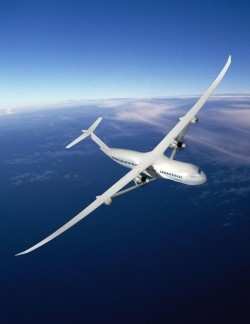Wed, Jan 09, 2013
Eight Demonstration Concepts Focus On Five Areas To Improve Airliner Efficiency
NASA has selected eight large-scale integrated technology demonstrations to advance aircraft concepts and technologies that will reduce the impact of aviation on the environment over the next 30 years, research efforts that promise future travelers will fly in quieter, greener and more fuel-efficient airliners.

The demonstrations, which are part of NASA's Environmentally Responsible Aviation (ERA) Project, will focus on five areas -- aircraft drag reduction through innovative flow control concepts, weight reduction from advanced composite materials, fuel and noise reduction from advanced engines, emissions reductions from improved engine combustors, and fuel consumption and community noise reduction through innovative airframe and engine integration designs.
The selected demonstrations are:
- Active Flow Control Enhanced Vertical Tail Flight Experiment: Tests of technology that can manipulate, on demand, the air that flows over a full-scale commercial aircraft tail.
- Damage Arresting Composite Demonstration: Assessment of a low-weight, damage-tolerant, stitched composite structural concept, resulting in a 25 percent reduction in weight over state-of-the-art aircraft composite applications.
- Adaptive Compliant Trailing Edge Flight Experiment: Demonstration of a non-rigid wing flap to establish its airworthiness in the flight environment.
- Highly Loaded Front Block Compressor Demonstration: Tests to show Ultra High Bypass (UHB) or advanced turbofan efficiency improvements of a two-stage, transonic high-pressure engine compressor.
- 2nd Generation UHB Ratio Propulsor Integration: Continued development of a geared turbofan engine to help reduce fuel consumption and noise.
- Low Nitrogen Oxide Fuel Flexible Engine Combustor Integration: Demonstration of a full ring-shaped engine combustor that produces very low emissions.
- Flap and Landing Gear Noise Reduction Flight Experiment: Analysis, wind tunnel and flight tests to design quieter flaps and landing gear without performance or weight penalties.
- UHB Engine Integration for a Hybrid Wing Body: Verification of power plant and airframe integration concepts that will allow fuel consumption reductions in excess of 50 percent while reducing noise on the ground.

"With these demonstrations we will take what we've learned and move from the laboratory to more flight and ground technology tests," said Fay Collier, ERA project manager based at NASA's Langley Research Center in Hampton, VA. "We have made a lot of progress in our research toward very quiet aircraft with low carbon footprints. But the real challenge is to integrate ideas and pieces together to make an even larger improvement. Our next steps will help us work towards that goal."
The Environmentally Responsible Aviation Project was created in 2009 and is part of NASA's Aeronautics Research Mission Directorate's Integrated Systems Research Program. During its first phase, engineers assessed dozens of broad areas of environmentally friendly aircraft technologies and then matured the most promising ones to the point that they can be tested together in a real world environment in the second phase. Those experiments included nonstick coatings for low-drag wing designs, laboratory testing of a new composite manufacturing technique, advanced engine testing, and test flights of a remotely piloted hybrid wing body prototype.
Each of the demonstrations, which are scheduled to begin this year and continue through 2015, is expected to include selected industry partners, many of which will contribute their own funding. "ERA's research portfolio provides a healthy balance of industry and government partnerships working collaboratively to mature key technologies addressing ERA's aggressive fuel burn, noise and emission reductions goals for tomorrow's transport aircraft," said Ed Waggoner, director of the Integrated Systems Research Program.
More News
Aero Linx: International Business Aviation Council Ltd IBAC promotes the growth of business aviation, benefiting all sectors of the industry and all regions of the world. As a non->[...]
"During the annual inspection of the B-24 “Diamond Lil” this off-season, we made the determination that 'Lil' needs some new feathers. Due to weathering, the cloth-cove>[...]
Also: Bushcat Woes, Hummingbird 300 SL 4-Seat Heli Kit, Carbon Cub UL The newest Junkers is a faithful recreation that mates a 7-cylinder Verner radial engine to the airframe offer>[...]
Also: Seaplane Pilots Association, Rotax 916’s First Year, Gene Conrad After a decade and a half of struggling with the FAA and other aero-politics, G100UL is in production a>[...]
Also: Martha King Scholarship, Montaer Grows, Textron Updates Pistons, FlySto The FAA is hiring thousands of air traffic controllers, but the window to apply will only be open for >[...]
 ANN's Daily Aero-Linx (04.16.24)
ANN's Daily Aero-Linx (04.16.24) Aero-News: Quote of the Day (04.16.24)
Aero-News: Quote of the Day (04.16.24) Airborne 04.10.24: SnF24!, A50 Heritage Reveal, HeliCycle!, Montaer MC-01
Airborne 04.10.24: SnF24!, A50 Heritage Reveal, HeliCycle!, Montaer MC-01 Airborne 04.12.24: SnF24!, G100UL Is Here, Holy Micro, Plane Tags
Airborne 04.12.24: SnF24!, G100UL Is Here, Holy Micro, Plane Tags Airborne-Flight Training 04.17.24: Feds Need Controllers, Spirit Delay, Redbird
Airborne-Flight Training 04.17.24: Feds Need Controllers, Spirit Delay, Redbird




